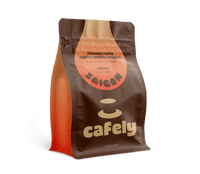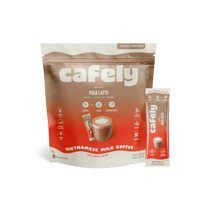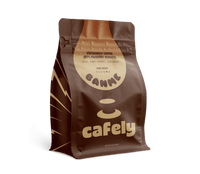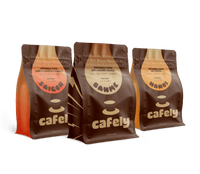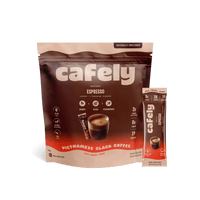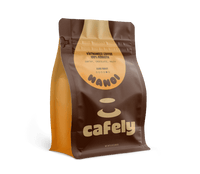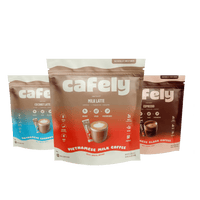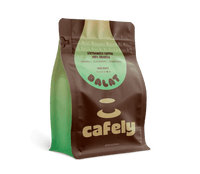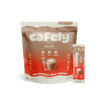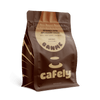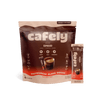The ibrik is a small Middle Eastern pot used for brewing coffee. It's often made from copper and is designed to be repeatedly placed on and off the heat of a stove.
The ibrik is used to make Arabic coffee — a strong, dark, unfiltered brew served in small demitasse cups called finjaans. Arabic coffee is made to be savored and enjoyed. An ibrik may be brewed and shared with a group of friends or family over an hour or two.
In this brew guide, you'll learn how to make Arabic coffee using the ibrik…
Ibrik Brewing Specs:
- Brew Time: 10–15 minutes
- Coffee/Water Ratio: 1:10
- Grind: Extra-Fine (similar to powdered sugar)
- Water Temperature: 208°F (98°C)
- Recommended Coffee: DaLat Coffee (100% arabica) / DaNang (Arabica/Robusta Blend)
Ibrik Brewing Summary
- Measure and grind the coffee.
- Add the coffee and water to the ibrik.
- Sweeten with sugar (optional).
- Heat and stir.
- Remove from the heat and harvest the foam (wesh).
- Repeat the process two to three times.
- Wait for the brew to settle.
- Serve the coffee and enjoy.
What You Need to Brew Coffee With an Ibrik

You don't need much in the way of tools or ingredients to brew coffee with an ibrik. However, you do need some specialist equipment and the ability to grind coffee to an extra-fine consistency — as fine as icing sugar.
Here's what you need to brew Arabic coffee with an ibrik:
Tools Needed
- Ibrik — This traditional coffee pot comes in a range of sizes from around 4 servings up to 20 servings. Smaller ibriks are generally easier for beginners to master.
- Coffee Grinder — You'll need a high-quality burr grinder to produce an extra-fine consistency. If your grinder isn't capable of grinding coffee to a powder-like consistency, opt for a pre-ground Arabica coffee.
- Weighing Scale — A weighing scale is essential if you want to make great Arabic coffee consistency.
- Tablespoon — You'll need a tablespoon to scoop the wesh (foam) from the ibrik throughout the brewing process.
- Demitasse Cups (Finjaan) — Arabic coffee is traditionally served in a “finjaan” — a small espresso-sized cup. If you don't have a finjaan set, you can use demitasse cups.
Ingredients
- Arabica Coffee — Use high-quality arabica coffee. Opt for freshly roasted whole-bean coffee if you can grind it extra fine. If not, select a high-quality pre-ground arabic coffee. (Arabica/robusta blends work too if you like very strong coffee).
- Water — Use fresh, filtered water for brewing Arabic coffee with an ibrik.
- Sugar (Optional) — Sugar can be added during the brewing process if you want to sweeten the coffee. You cannot add sugar after the coffee is brewed.
Coffee Recommendations
Traditional Arabic coffee made with an ibrik uses finely ground Arabica. Arabica coffee is ground extra-fine — a consistency similar to powdered icing sugar. This can be achieved with a high-quality burr grinder. If you don't have a grinder capable of grinding coffee this fine, opt for a pre-ground coffee that's been formulated for Arabic brews.
Arabic coffee, such as Greek and Turkish coffee, highlights the delicate flavors of arabica coffee. It's important to select a fresh, recently roasted arabica coffee if you want to make a stand-out brew. We recommend our DaLat 100% arabica if you have a good enough grinder to produce an extra-fine grind.
If you want a pre-ground arabica suited to Arabic brews, we recommend Kurukahveci Mehmet Efendi, Café Najjar, and Mariam Turkish coffee.
Step-by-Step Brewing Instructions: The Ibrik
Brewing coffee with an ibrik is a relatively simple process, but it's more involved than most other brewing methods. It takes a while to master, so make sure to set some time aside, and don't expect to create the perfect coffee the first time around.
Here's how to brew Arabic coffee using an ibrik:
1. Measure & Grind the Coffee

Arabic coffee made in an ibrik requires dark roast arabica coffee that has been ground extra-fine — a texture similar to powdered sugar (finer than an espresso grind).
You will need one to two teaspoons of finely ground coffee per serving of Arabic coffee. To achieve an extra-fine grind, set your burr grinder to its finest setting. If your grinder isn’t capable of producing such a fine grind, opt for a pre-ground Turkish, Greek, or Lebanese arabica.
2. Prepare the Ibrik

Measure out cold, fresh, filtered water and fill your ibrik. You’ll need around 60 mL of water per serving.
Place the desired amount of water and coffee in the ibrik but don’t stir it just yet — doing so can cause the fine grounds to clump together.
3. Add Sugar (Optional)

You can add sugar to some Arabic brews. If you wish to sweeten the coffee, you must add the sugar before the brewing process begins.
Here’s a guide for sweetening your Arabic coffee:
- Unsweetened — No sugar.
- Lightly Sweetened — ½ a teaspoon per serving.
- Medium Sweet — 1 teaspoon per serving.
- Sweet — 1 ½ to 2 teaspoons per serving.
4. Heat and Stir the Brew

Place the ibrik over low heat on your stove. Gas stoves work best for brewing coffee with an ibrik, but electric hobs also work.
As the ibrik begins to heat, gently stir to combine the ingredients thoroughly.
Continue heating and stirring the brew slowly — don’t let the ibrik boil. When you start to see a foam (wesh) form on top of the brew, stop stirring.
5. Harvest the Wesh (Foam)

When the wesh rises to the top of the ibrik, just before it begins to boil, remove the ibrik from the heat. Take a tablespoon and gently scoop some of the wesh into your finjaans or demitasse cups.
6. Repeat the Process

After harvesting the wesh, return the ibrik to a low heat and wait for the thick foam to rise again. Remove the ibrik from the heat, harvest the wesh, and repeat the process another two to three times.
7. Pour and Serve

Once the Arabic coffee has been brewed completely, remove the ibrik from the heat and leave it on the counter for two minutes. This will allow some of the fine coffee grounds to settle.
Pour the coffee slowly and gently into the finjaans and watch the wesh rise to the top. Leave the coffee for one to two minutes before drinking to allow the fine grounds to settle once again.
Tips for Brewing Coffee With an Ibrik
Brewing Arabic coffee with an ibrik is an art form. Like chess, the ibrik takes minutes to learn but years to master. A few tips will help you understand the process of brewing Arabic coffee with an Ibrik and will hopefully speed up your brewing journey.
Here are a few tips to help you brew better coffee with an ibrik.
1. Perfect the Grind Size
The grind for an ibrik must be extremely fine. The coffee should have the texture of flour or powdered icing sugar. If you cannot achieve this grind, the brew will taste under-extracted, gritty, and silty.
The super fine grind allows for maximum extraction, providing the characteristic strong flavor that Arabic coffee is famed for. It also ensures the coffee settles at the bottom of the ibrik and finjaans — essential because this coffee is unfiltered.
Use a high-quality burr grinder to produce a consistent grind. If your coffee has larger grains in it, run it through the grinder again and sift it with a mesh screen afterward to remove any larger pieces.
It's impossible to over-grind arabica coffee for use in an ibrik. However, if you need to grind for a prolonged period, the heat from the machine can scald the coffee slightly, impacting its flavor. Grind the coffee in bursts and be patient until the perfect consistency is achieved.
2. Select the Right Size Ibrik
The size of your ibrik influences how evenly the coffee brews and whether you'll produce the signature wesh (foam) that makes Arabic coffee unique.
A smaller ibrik is easier to use as you're able to control its heat more efficiently. You should use an ibrik that's slightly bigger than the volume of coffee you want to brew. For example, if you want to brew four ounces of coffee, select a 6 oz ibrik. This extra room allows the coffee to expand and foam.
A larger ibrik than necessary can cause uneven brewing and a lack of wesh, while one too small will overflow during brewing.
Make sure to select the right size ibrik, and even if you only want a single serving of coffee, never underfill it. If you're a beginner, it's best to start with a smaller ibrik for better control and consistency. Additionally, you can pair it with the best coffee selections for beginners.
3. Monitor the Brewing Process
The brewing process for making Arabic coffee with an ibrik is tedious. It requires close monitoring if you're to create a charismatic, dark brew, with the signature wesh on top.
Keep an eye on the heat. The ibrik should heat slowly and never boil. Be patient and avoid cranking up the heat because it feels like it's taking too long.
Watch the coffee and remove it from the heat as the foam starts to rise just before it boils. Harvest the foam gently, without disturbing the brew below, and return to the heat before the ibrik cools too much.
4. Let the Coffee Rest Before Serving
Arabic coffee made with an ibrik is unfiltered. If you find your coffee tastes silty or overly thick, you may need to leave your ibrik to settle for longer.
Once you've finished brewing, stand the ibrik on the side for at least two minutes before pouring the brew in the finjaans. Once you've served the coffee, let it rest in the finjaans for another one to two minutes.
This two-step resting process ensures fewer grounds reach the final cup and the grounds that do have time to settle.
When drinking your Arabic coffee, sip it slowly to avoid disturbing the fine grounds at the bottom. Avoid drinking the whole cup — leave the last sip (this contains the grounds).
FAQs: The Ibrik
Do you want to learn more about the ibrik, Arabic coffee, and other brewing methods?
Head over to the Cafely Blog or read the answers to the frequently asked questions below:
1. What is an Ibrik?

An ibrik is a traditional coffee pot that's used to boil finely ground coffee to produce a strong, dark, unfiltered brew. It's used on a stove, hot sand, or open fire and is regularly placed on and off the heat during the brewing process.
2. Is an Ibrik the Same as a Cezve?
Yes. The ibrik and cezve are both the same type of small brewing pot used to make coffee. “Cezve” is the Turkish word for the pot, and “ibrik” is the general Arabic term for the pot.
3. What is Turkish Coffee?
Turkish coffee is a traditional arabica brew made by boiling finely ground coffee in an ibrik (traditional coffee pot) several times. It's a strong, bold brew that's unfiltered. It’s served in small demitasse cups and is sipped slowly, usually with a group of friends or family.
4. How Much Caffeine is in Turkish Coffee?
There is approximately 50 to 70 mg of caffeine in a 60 mL serving of Turkish coffee. The exact amount can vary depending on the beans used and the extraction time.
5. Is Turkish Coffee Similar to Espresso?
Turkish coffee is similar to popular espresso coffee in that it's a concentrated shot of coffee with a relatively high caffeine content per milliliter. However, Turkish coffee is much more floral and aromatic. It also has a thicker mouthfeel thanks to its unfiltered nature.
6. Can You Make Turkish Coffee Without an Ibrik?
You can't make a true traditional Turkish coffee without an ibrik. However, you can make a similar brew by using a small milk jug or stovetop pan.
7. What’s the Best Coffee Beans to Use for Arabic Coffee?
The best coffee beans for Arabic coffee should be freshly ground to an extra-fine consistency — similar to powdered icing sugar. Arabica coffee is favored for its smooth, sweet nature and bold, nutty, floral flavors.
8. Is Turkish Coffee the Same as Greek Coffee?
Turkish coffee and Greek coffee are essentially the same in terms of preparation, brewing equipment, and style. They are both made using an ibrik, and both cultures prize the rich “wesh” (foam) that's produced during the brewing process. The key difference lies in the cultural identity of each brew.
9. What is a Moka Pot?
A moka pot is a stovetop coffee maker that works by forcing hot water through finely ground coffee. The moka pot produces a short, concentrated brew with similar qualities to espresso. It's used by filling the bottom chamber with water and the filter basket with finely ground coffee before placing the pot over medium heat. As the water heats, it's pushed up through the coffee into the top collection chamber.
10. Can You Make Turkish Coffee With Milk?
Traditionally, Turkish coffee is never made with milk. It's served black and can be sweetened with sugar during the brewing process. It's difficult to add milk to Turkish coffee after brewing because disturbing the brew disperses the fine grounds at the bottom of the cup, leading to a silty, gritty brew.
